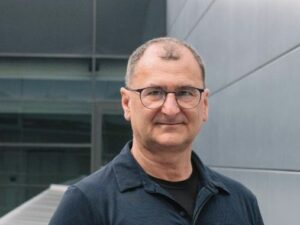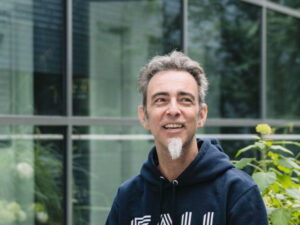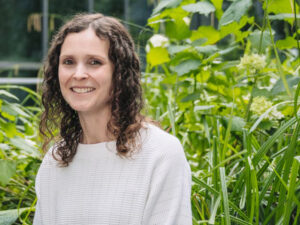On the sunny side
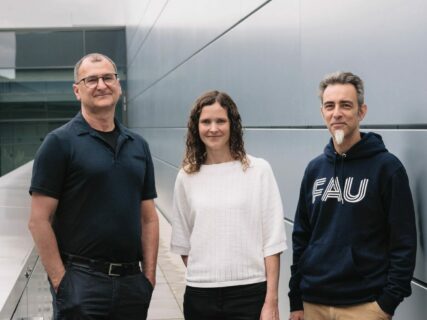
How photovoltaic technology can be advanced
Limited efficiency, difficult to recycle and no notable production sites in Germany. There is much to improve when it comes to photovoltaic technology. Christoph Brabec, Verena Tiefenbeck and Ian Marius Peters have now come together to give photovoltaic technology new impetus.
Christoph Brabec is looking for the perfect material. Or, to put it more accurately, for the perfect material for solar modules of the future. “Silicon dominates the market,” he says, “but we know that even this technology has its limits after more than 75 years of research and development.” On the one hand, these limits refer to performance, as an efficiency level of more than 30 percent is theoretically not possible for a simple silicon module. On the other, they can only be installed on roofs and in open spaces because they are rigid and heavy and light cannot pass through them.
Brabec, Professor of Materials in Electronics and Energy Technology at FAU and Director of the Helmholtz Institute Erlangen-Nürnberg for Renewable Energy (HI ERN), researches into alternatives, especially organic photovoltaics. “We can print organic semiconductors directly onto thin substrates. This simplifies the production process and requires significantly less energy,” he explains. “Since organic photovoltaic modules can be flexible and transparent, they can be integrated into windows and building facades, used inside rooms, or as roofs in fields where plants can be grown underneath them.”
The search for the perfect material for semiconductors usually involves making compromises. Polymers with long chains of molecules are durable and resistant to changes in temperature, but their structure means that they have only limited efficiency, particularly in low light conditions. Short chains of molecules supply more electricity, but have a shorter operating life. Brabec and his team recently identified something known as an oligomer as a promising candidate for organic photovoltaic systems, combining as it does both performance and robustness.
They are also developing polymers that do not function as active semiconductors but as a passive protective layer, for example in perovskite solar cells. Perovskites are metallic crystals that have excellent optoelectronic properties and are easier to use than silicon, but are extremely prone to corrosion. The purpose of the polymer layers is to protect against this corrosion, while allowing the electrons released to pass unhindered.
Success such as this is not possible without complex fine tuning of the atomic structure. This is not something that can be taken for granted. Trial and error are the rule and not the exception. The aim of the researchers at HI ERN is to automate these experiments. “We want to reproduce all processes, from the selection of the materials to the test cycles themselves, in a type of digital twin,” says Brabec. “Using AI-assisted development means we can avoid many repetitions and hopefully make breakthroughs more quickly in this important technology.”
Performance is not everything
Performance and long life are not the only criteria for the perfect solar module. “We must not allow ourselves to get distracted by the struggle for maximum efficiency levels,” says Ian Marius Peters, team leader at HI ERN. It is also crucial that photovoltaic modules and all their individual components leave an ecological footprint that is as small as possible during their entire lifecycle.
This begins as early as the choice of semiconductor layer. A photoactive polymer that can be manufactured in only a few steps is potentially preferable to a material that has a more complex and energy-intensive manufacturing process but ultimately has 2 percent higher performance. “It is also crucial for us to be able to process polymers without toxic solvents that are harmful to the environment,” explains Peters. Cheaper and more environmentally-friendly processes for synthesis such as deposition from water-based solutions and printing using inkjet processes are therefore a central field of research at HI ERN.
The “cradle-to-cradle” approach pursued by Peters naturally also involves the question of what happens to the products at the end of their life. “Silicon modules have a longer life, but are extremely difficult to recycle,” he says. “They usually end up at rubbish dumps or they are shredded and only partially recycled.” The solution lies either in a multi-layered design that allows various materials to be easily separated from each other and recycled, or in consistently manufacturing the entire module from organic materials that can ideally be composted. “A module doesn’t need to last for 100 years if the technology is no longer up-to-date after 20 years,” explains Peters, who was awarded an ERC Consolidator Grant worth 2 million euros for his research in 2023.
Technology needs acceptance
A holistic approach to the consideration of the ecological footprint of a product could increase its acceptance with consumers, especially considering the fact that the decision to purchase solar modules is a decision in favor of green sources of energy. Verena Tiefenbeck researches such consumer preferences and the opportunities for the market that arise from them. As professor of digital transformation at FAU, she investigates the interface between companies and consumers. Her research involves looking at how new products and technologies are accepted by people and integrated into their everyday lives. “Organic solar technology is a disruptive innovation,” she says. “There currently isn’t a large amount of data and as consumers, we don’t have many choices or means of making comparisons.”
Tiefenbeck is trying to look into the future to outline scenarios for various conditions. These are predominantly based on political decisions such as subsidy programs, bans on products that harm the environment or guidelines on the degree of recyclability. “If these conditions change, they are referred to as shocks in macroeconomics,” she explains. “Shocks can be dramatic, but they can also help new technologies achieve a breakthrough.”
In addition to political interventions, there is a series of other factors that influence a product’s future and its chances on the market. One of these factors is dependency on raw materials. “The more materials we have to import from other countries, the less able we are to calculate the price development in the medium and long term,” she says. “Geopolitical instabilities can also lead to supply bottlenecks.” The regions of the world they come from and the conditions under which raw materials are extracted is also important for the acceptance of a technology in society. This is one of the reasons why carbon-based electronics and photovoltaics are a bearer of hope: Not only are they more environmentally friendly, but they do not require rare earth or precious metals.
by Matthias Münch
FAU Profile Center Solar (FAU Solar)
The sun is one of the most important sources for renewable energy, solar energy is a central component of the energy transition. However, photovoltaics continue to have serious limitations, above all in terms of their performance, which are preventing their rapid expansion. FAU Solar is researching into strategies to overcome these limitations. These include printing organic semiconductors as well as using a holistic approach to the consideration of the product lifecycle including recycling. Artificial intelligence is used to optimize the processes along the entire value chain.
This article is part of the FAU Magazin
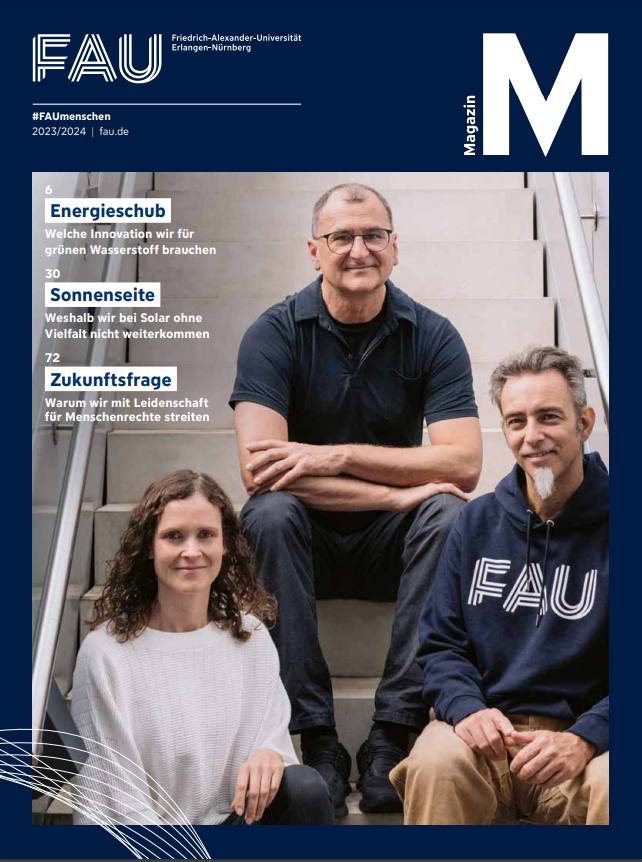
A university thrives because of the people who research, study, teach and work there. A university is supported by people who are connected to it as alumni, friends and sponsors and who are committed to promoting its interests all over the world.
They all contribute their unique talents, skills and perspectives. It is this diversity that makes our FAU a place of innovation, a place where many talented individuals tackle the major challenges of our times together, and a place where they keep finding answers.
Read more articles online Download: FAU Magazin (PDF)